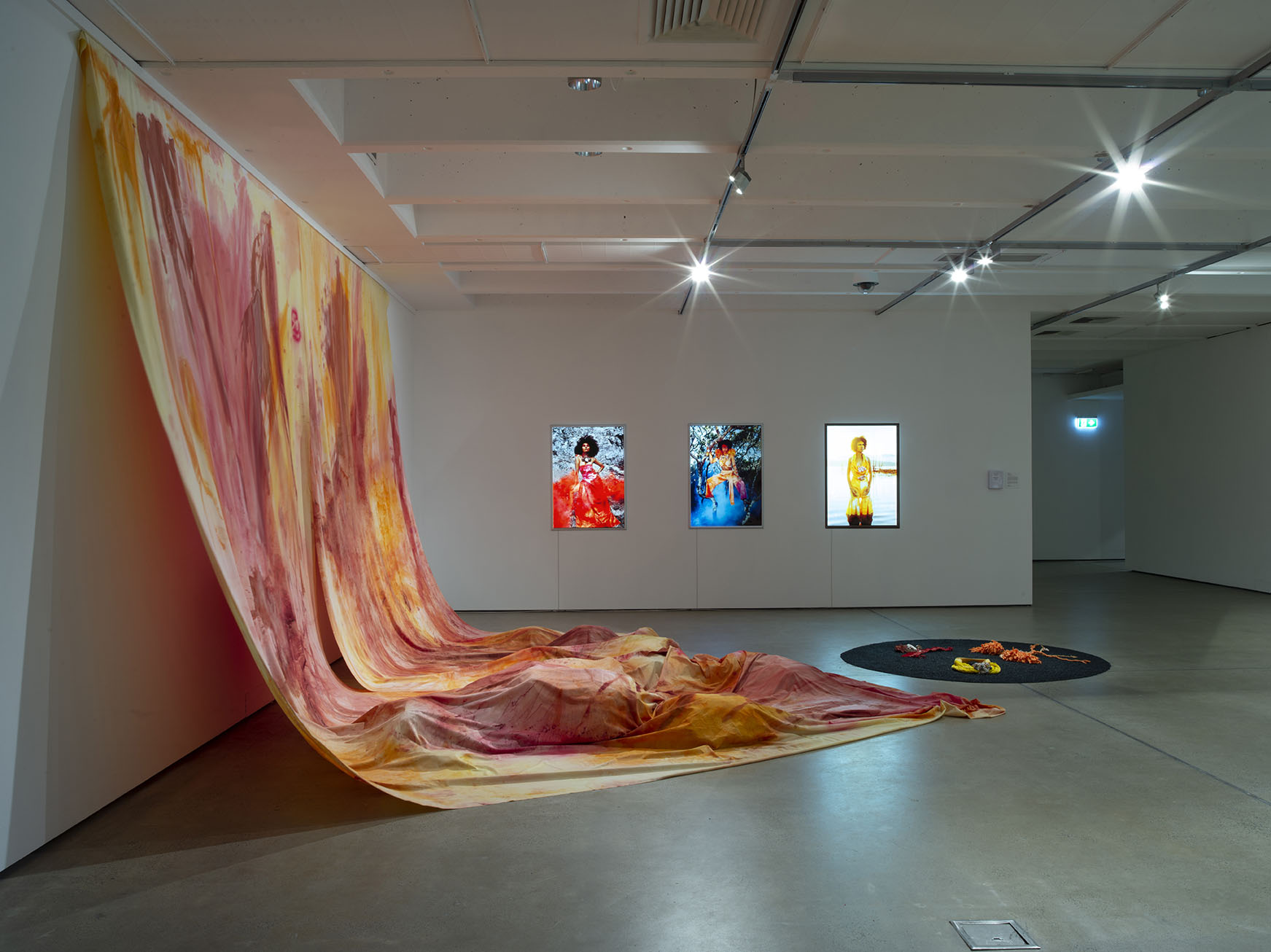Shows
“The Commute”


I offer my thoughts on “The Commute,” held at Brisbane’s Institute of Modern Art (IMA), as an uninvited guest on Australian lands. This exhibition featured perspectives of eight artists and five visiting curators native to Pacific Rim geographies, giving back (some) cultural agency to First Peoples within institutional walls. The show reflected on a wider Indigenous consciousness prevalent across the region through the concept of “commuting cultures,” whereby the diversity and cultural richness of the region is established through a complex dynamic between spiritual connection to place, journeying, displacement and settler impact on sacred lands and inhabitants.
Several artists expressed their culture through handmade items of spiritual and personal value. Commanding the viewer’s attention upon entering the exhibition space was Skin Country (2018), Carol McGregor’s oversized possum-skin cloak detailing the rich plant-based history of Brisbane. The Wathaurung and Scottish artist’s ocher and charcoal illustrations of native flora used by local Indigenous cultures reinforce strong connections to land. The next room housed Bracken Hanuse Corlett’s recreated “dance blanket” Qvùtix (2018). This traditional Wuikinuxv object depicts his family’s previously lost crest of a thunderbird and double-headed serpent on one side, whilst the other brings it to life through projected animation.
Emphasis on tradition is further established by the Kānaka Maoli and Sḵwx̱wú7mesh artist T’uy’t’tanat-Cease Wyss, and Natalie Ball, an artist of Madoc and Klamath descent. Wyss references traditional healing properties of plants, sourced from Coast Salish, Kānaka Maoli, and Greater Brisbane Aboriginal lands, in her apothecary-like installation SḴ’éytl’tanaỳ (Medicinal Plants) (2018), while her VR works transport visitors to a beach on Oahu and Stawamus River in the Squamish Valley. Nearby, Ball’s “power objects”—mixed-media sculptures composed of tightly bound beaded moccasins, a coyote skull, shell beads, synthetic hair, plastic dolls and other incongruous items—evoke tension and violence, highlighting the fraught impact of colonizers on Native American people.

Sāmoan artist Chantal Fraser and Kānaka Maoli, iTaukei Viti and Pākehā artist Ahilapalapa Rands take a more playful approach to expressing settler repurposing of sacred lands. Fraser’s lone diamanté-encrusted
wind turbine The Way (2018) appears alluring, yet vulnerable and out of place in the large room it occupies, reflecting the exoticized and displaced Indigenous experience. The fully functional but limp structure references the turbines that feed off energy on native Cahuilla land in Southern California, an ironic attempt to rectify previous environmental damage caused by settler exploitation. Rands’s first foray into animation critiques the blatant disregard of local celestial ideologies evidenced by the development of observatories on the sacred Hawaiian mountain, Mauna Kea. The artist’s three-channel animation Lift Off (2018) utilizes the cultural power of an ipu beat to dislodge these foreign objects when played by a female Kumu Hula (hula teacher). The observatories perform a spasmodic dance above the mountain, before eventually exploding. Referencing themes of science fiction and Indigenous Futurisms, Rands imagines a world where Kānaka Maoli have agency over their own land and culture.
Yaegel artist Hannah Brontë also envisions a future of strong Indigenous women in her installation Futcha Ancient (2018). Ethereal lightbox portraits of three “sisters” represent past, present and future histories in a parallel world unaffected by colonization. Each woman is clothed in vivid, naturally dyed fabric and oversized shell necklaces reminiscent of protective armour. Accompanying these portraits is a cascading mass of fabric painted in earthy hues attached to a nearby wall, and a circle of black sand providing a bed for the three necklaces. The power of solidarity is further emphasized in Lisa Hilli’s adjacent work Sisterhood Lifeline (2018). The Gunantuna artist’s vibrant photographs of embracing Pacific women covering the walls overshadow the small office cubicle in the corner of the space. Sterile and
cut off from these exterior images of affection, the interior walls and answering machine are populated with messages of love and encouragement—a much needed comfort whilst working within marginalizing institutional settings.
The multiple Indigenous curatorial and artistic voices presented within “The Commute” established a sense of community, strength and empowerment. Together these similar yet distinct perspectives encouraged a more inclusive mentality in Indigenous and non-Indigenous viewers alike by deepening acknowledgement and awareness of neglected cultures and histories. As visiting curator Tarah Hogue states in Wyss’s exhibition text: “To be a guest is to honor the responsibility to learn and to go gently.”
“The Commute” is on view at the Institute of Modern Art, Brisbane, until December 22, 2018.







